
-

Running is a great way to stay in shape and relieve stress, but it's also a fairly high-impact sport. Your entire body must absorb shock each time your feet strike the ground. Running shoes are designed to provide lightweight, flexible support and cushioning to absorb repeated impacts. However, it’s important to know that foot types vary, and different shoes provide different benefits. Some runners need extra cushioning. Others may need more stability. To help you choose a pair of running shoes that will work well for your feet, we consulted Dr. Thomas Hecker, D.P.M., and Bill Michel of Runners Roost in Fort Collins, Colorado.
"Running shoe companies spend big money trying to prevent injuries caused by biomechanical problems," says Bill Michel. "How the shoe works with your mechanics is critical to running healthy." Keep in mind that everyone is unique, and finding a “perfect” shoe is unlikely. However, if you spend a little time identifying your running style and foot shape, you'll have much better odds of finding a pair that will fit your needs.
Just looking for quick tips? Check out our Infographic.
-

There are four main styles of running shoes, each designed to accommodate a certain type of runner:
Cushion Running Shoes
This style is the most flexible and encourages natural pronation. It also offers extra shock absorption and doesn’t have stability or motion control features. Cushion running shoes are best for people with a high arch and also people with an average arch.
Stability Running Shoes
These have light support features on the medial side and well-cushioned midsoles to help guide mild-to-moderate overpronation. Stability running shoes are ideal for feet with a moderately flat arch.
Motion Control Running Shoes
This category incorporates extra stability features on the medial side to help control severe overpronation. Runners with very flat arches may need the extra support and stability of motion control shoes.
Minimalist Running Shoes
One of the newest categories of running shoes available on the market, minimalist footwear is designed for people who prefer a midfoot or forefoot running style, less cushioning and no stability or motion control features.
-
If you’ve never been fitted for running shoes before, it’s very important that you get to know your arch type and degree of pronation. "We see a lot of injuries resulting from poor shoe choice," says Dr. Thomas Hecker, D.P.M. "Most people don't know what type of running shoe is best for their foot." Pronation is the term used to describe the normal motion of the foot rolling slightly inward through the foot strike. Pronation is essential to shock absorption and forward propulsion. It's when you overpronate or underpronate that you need to be particular about the running shoe you choose.
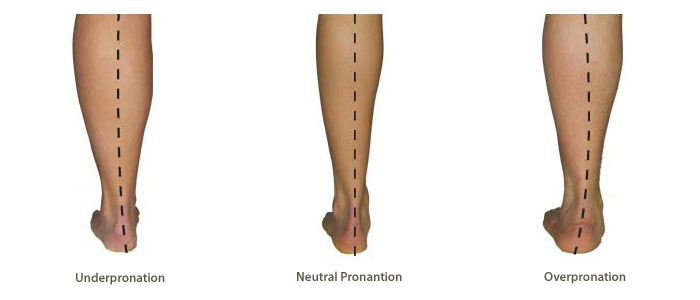
What Kind of Pronator Are You?
The arch of your foot plays a major role in pronation. The three different arch types (normal, flat, and high) correspond to the degree of pronation you're most likely to experience. You can get a good idea of your arch type by doing a "wet foot test." Just follow the simple steps below.
- Wet the bottom of your foot
- Step onto a piece of dark construction paper or non-laminated cardboard
- Match your imprint to one of the arch types below to determine your degree of pronation
Note: Another way to determine arch type is to look at the outsoles of your old running shoes, although this method is less reliable than the "wet foot test." If the sole is worn equally on both sides, you most likely have a normal arch. If you have a flat arch, the sole will show excessive wear on the inside. A high arch usually produces a sole with noticeable wear on the outside. Be sure to look at the wear pattern on the entire shoe, and not just the heel.
Normal Arch = Neutral Pronation
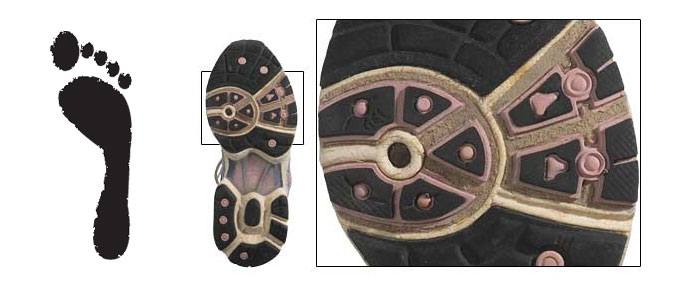
Notice the wear pattern is uniform and centered closer to the middle of the sole. The textured rubber is still present on both sides of the sole. The most common arch type, the normal arch, leaves a wet print with a flare and a broad band connecting the heel and the forefoot. This foot type is a neutral pronator and rolls inward slightly to absorb shock. If you have a normal arch, you're considered bio-mechanically efficient and don't need motion control features. The best part about having a normal arch is that you have more freedom when picking a running shoe.
The Shoes for You: Cushioning or Stability
Cushioning running shoes are the most flexible and encourage natural pronation, with added arch support and shock absorption. Alternatively, some neutral runners may prefer Stability shoes with light support features on the medial side. If you run with a midfoot-strike style, you may prefer minimalist shoes. Avoid motion control shoes.
Flat Arch = Overpronation
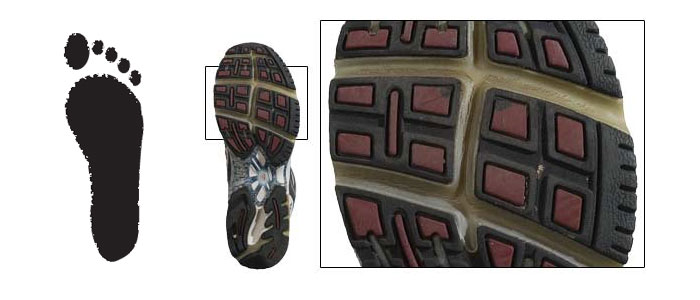
Notice the increased wear and lack of texture on the medial side (inside) as compared to the lateral side (outside), which still has the texture intact. If you make a complete or nearly complete foot imprint, you have a Flat Arch. This type of foot is commonly associated with overpronation, or an excessive inward roll after heel strike. The flatter the arch, the more support and motion control you need.
The Shoes for You: Stability or Motion Control
Ideal for low arches, Stability shoes have light support features and well-cushioned midsoles to help guide mild-to-moderate overpronation. If you have very flat feet, you’ll be much better off with Motion Control shoes that incorporate extra stability features on the medial side to help control significant overpronation. Steer clear of cushion shoes and minimal shoes that lack stability features.
High Arch = Underpronation (Supination)
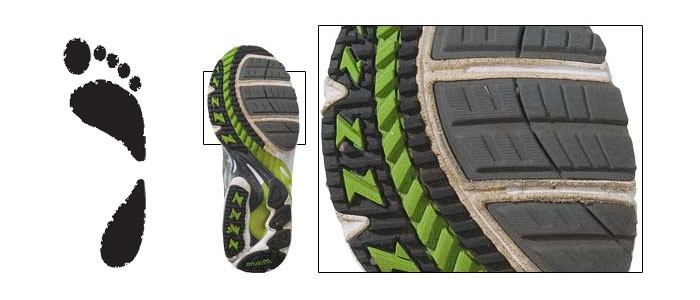
Notice the increased wear on the lateral side (outside) while the medial side (inside) is relatively untouched. The least common arch type, the High Arch, will produce an imprint showing the heel and forefoot connected by only a thin band. This foot type usually doesn't absorb shock well because it rolls outward or underpronates (also known as supinating).
The Shoes for You: Cushioning
Cushioning shoes are the most flexible and encourage pronation. They incorporate extra cushioning, arch support and shock absorption. For even more arch support, you may also consider buying a customized pair of insoles. If you try minimal shoes, be aware this style offers only limited cushioning and light arch support. Avoid Motion Control shoes and Stability shoes.
-

Sizing Up
Many runners find the best fit comes from going up at least half a size up for a little extra room in the toe box. If you normally wear a size 10 shoe, you may prefer a 10.5 or even an 11 for running. Another issue noted by Dr. Hecker is that many people already tend to wear shoes that are too small for their feet. Aim for a thumb's width between your longest toe and the end of the shoe. Also remember that your foot will expand when running. Sizing up will help you avoid black, and soon-to-be missing, toenails.
Retire Worn-Out Running Shoes
Unless you only run when the moon is full, your running shoes won’t last as long as your everyday shoes. Wearing worn-out shoes is as bad as wearing shoes that don’t fit. "Many injuries occur because a runner continued to wear a shoe after it had broken down", says Dr. Hecker. "Most injuries can be remedied with a simple change of shoe". On average, running shoes are only designed to handle about 500 miles. For example: If you put in five miles, five days a week, your shoes will probably be toast in less than six months. Also, according to Dr. Hecker, people with higher arches wear out their shoes faster.
Rotate Your Running Shoes
If you find a pair that you really like, we highly recommend getting a second or even a third pair. Many runners choose to rotate several pairs of running shoes at the same time, even if they're the same make and model. Once you get all your shoes broken in and start a rotation, you’ll go much longer before buying and breaking in a new pair. Plus, if you can’t find your favorite model in six months, you’ll already have another pair ready to go, giving you ample time to shop around for another model that you’ll like.
Get Running Socks
Owning several pairs of lightweight, moisture-wicking, breathable running socks is totally worth the small investment. Synthetic blends and merino wool blends are generally the best. Avoid cotton socks. They don’t wick moisture well and dry very slowly, which can contribute to abrasion, hot spots and blisters.
Don't Judge a Shoe by Its Cover
Never choose a pair of running shoes based on looks alone. You won't care what color they are if your feet hurt.
Go Mesh
Most running shoes have mesh uppers, and this is a very important feature. Mesh breathes well and provides necessary ventilation. This will help keep your feet cooler and drier, which will minimize bacterial growth and odor.
Invest in Quality
A trip to the doctor or physical therapist will end up costing you a lot more (in money and discomfort) than you could ever save by purchasing cheap, off-brand shoes at the discount store. Consider putting your trust in a proven brand name like New Balance, Brooks, Asics, Saucony or Pearl Izumi.
-

Many people underestimate the power of proper lacing. Instead of overtightening your shoes, try these simple techniques to ensure a secure fit. "Forefoot nerves are superficial and easily damaged by shoe laces that are tied too tight, "says Dr. Hecker. Use the extra eyelet at the top of the shoe to "lock" the laces in place.
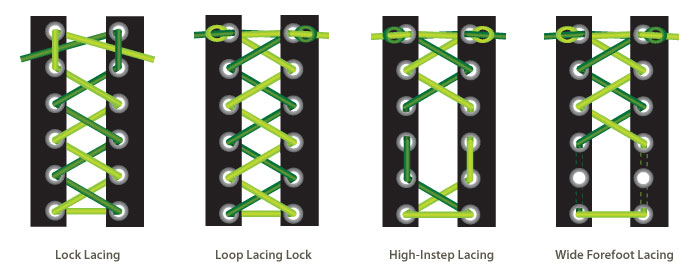
Lock Lacing for Heel Slippage
If you experience heel slippage, lock lacing will help. Lace the shoe normally until the lace ends emerge from the second set of eyelets. Then feed the laces up each side and into the top eyelet towards the foot. Now cross laces over, and feed each under the vertical section of the other side. Pull and tie normally.
Loop-Lacing Lock
This method of lacing is great to ensure a secure fit for any running shoe. After lacing, put each lace end back through the last hole to create a small loop on the top side of the shoe. Thread each loose end through the loop on the opposite side, pull and tie to create a tight closure.
High-Instep Lacing
If you have a high instep, this lacing technique might make you more comfortable. Start with normal lacing at the bottom, then feed the laces up each side of the shoe and cease to criss-cross. Once at the top, continue the criss-cross technique and tie for a secure closure.
Wide Forefoot Lacing
If you have a wide forefoot, consider buying shoes especially designed for this issue. You can also try this simple technique. Begin by feeding the laces up each side of the shoe and only use the criss-crossing technique towards the top. Tie for a secure closure.
-

Beginning around the late 2000s, a new way of thinking about running started to gain mainstream attention. The minimalist philosophy centers around the view that natural biomechanics are better for runners than high-tech footwear. In other words, minimalists believe that running barefoot is actually better for the body, as long as proper form is used. Unfortunately, the unprotected human foot isn’t well-designed for running around barefoot. To solve this problem, footwear companies began to experiment with minimalist running shoes.
What Are Minimal Running Shoes?
Traditional running shoes place protective rubber soles and shock-absorbing midsoles under the foot, with slightly more material under the heel. This is because many athletes run in a heel-strike style, where the heel contacts the ground first, followed by the midfoot, followed by the forefoot push-off. In running shoes, “offset” is the difference between the height of your heel and the height of your forefoot when your foot is inside the shoe and resting on a flat surface. Another way to describe offset is heel-to-toe drop. “Zero-drop” shoes, for example, keep the heel of the foot on the same plane as the toes, with zero offset. Traditional running shoes have more drop than minimalist shoes.

There are two main categories of minimalist running shoes:
- Barefoot running shoes fit like a glove and have the bare minimum of material underfoot, with very little cushioning and no offset between the heel and toe (zero drop). These shoes are designed to be worn without socks. Some models even have individual compartments for each toe, allowing the toes to flex and move individually. Barefoot running shoes take time to get used to, especially if you’re accustomed to traditional shoes. They also provide the least amount of shock absorption.
- Minimalist running shoes occupy a middle ground between super-minimal barefoot shoes and traditional running shoes. This style offers a little more cushioning and a slight heel-to-toe drop, usually less than 6mm. Although they’re lighter and less cushioned than traditional running shoes, minimal shoes still provide some shock absorption.
Should You Try Minimalist Running Shoes?
This largely depends on two factors: your running form and your feet. In order to run safely and efficiently in this kind of footwear, a midfoot strike running style is preferred. Running this way isn’t simply a matter of switching shoes or changing how your feet contact the ground. It involves working on your entire running form. Correct posture, cadence and a slight forward lean will help keep your body properly aligned for an efficient midfoot running style. If you’re used to running in a heel strike style, adapting to midfoot style will take practice, and it’s important not to rush the transition. If you can comfortably run five miles in traditional shoes, start with only one or two miles in your new minimal shoes, adding more distance gradually over several months. Focus on your form, not your speed or distance. Of course, you can run using a midfoot strike style and still wear traditional running shoes. In fact, some runners prefer it. It’s all a matter of what works best for you.
Your feet and body are another big consideration. Minimal shoes don’t offer much cushioning. Barefoot shoes offer almost none. If you’re prone to injury, such as plantar fasciitis or Achilles’ tendinitis, you should pay extra attention to your form. Running with a midfoot strike in minimalist running shoes requires a consistant technique and strengthening different muscles. You may even consider practicing midfoot form in a pair of traditional running shoes first. Once you feel comfortable with your form, switch to minimalist shoes with a moderate heel-to-toe drop. If you still crave less, you can eventually transition into barefoot running shoes. Many people have experienced personal gains by switching to minimal shoes, but rushing the transition can potentially lead to injury.
Keep in mind that there is still an ongoing debate about the benefits of minimalist running shoes vs. traditional running shoes. Some running companies, such as Hoka One One, actually prefer to create shoes with minimal heel-to-to drop and very thick cushioning underfoot, even more cushioning than traditional running shoes. Some people call these “maximalist” running shoes. Ultimately, it’s all a matter of personal preference and what works best for you.
Making the Switch
Changing the style of running shoes you wear may be a way to improve your running experience, or it may not make a difference. Just be careful when transitioning from one type of shoe to another so you don’t get injured. Give your feet and body time to slowly adapt to shoes with different levels of drop and/or cushioning. Finding shoes that work well with your running style and individual biomechanics is the most important thing. If you’ve been running for years with a heel-strike style and haven’t had any issues, stick with what works. If you’re considering going minimal to improve your form and reduce impact on your body, make the transition slowly. If you’ve never run before, figure out what form works best for you, then buy shoes to match. Consider consulting with a certified running trainer or podiatrist, especially if you experience pain or discomfort.
-

Trail Running Shoes
Trail running shoes have more aggressive tread on the soles to provide traction on off-road terrain. Some trail running shoes also have a waterproof breathable membrane, such as Gore-Tex®, to keep your feet dry in rainy, muddy or snowy conditions. Just like regular running shoes, trail running shoes come in traditional and minimalist styles.
Cross Training Shoes
Cross training shoes are the most versatile athletic shoe, but aren't recommended for distance running. Designed for low-impact activities that require lateral support, they're excellent for weight training, stair climbing, aerobics, step classes, etc.
Walking Shoes
Walking shoes are heavier and less flexible than running shoes, usually with leather uppers for more durability. Although running shoes are perfectly suitable for walking and casual wear, it’s not a good idea to run in a pair of walking shoes.
Court Shoes
Court shoes are designed with better traction for tennis, racquetball, squash and basketball. The sole is typically sewn to the upper for added durability and support. This style of footwear is great for high-impact, side to side motion, quick movements and short sprints, but not ideal for distance running.
-
Sources for this Guide
- Dr. Hecker received his D.P.M in 1994 from Scholl College of Podiatric Medicine and currently practices at the Orthopaedic Center for the Rockies in Fort Collins, CO.
- Bill Michel is the Assistant Manager of the Runners Roost in Fort Collins, CO.
Additional Resources